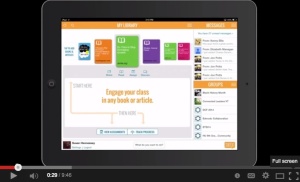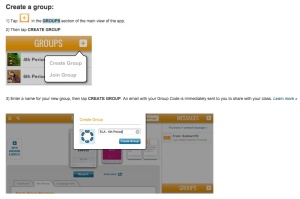Make the most of Subtext’s capacity for differentiated reading
 A-reading we will go, A-reading we will go, hey ho the dairy-o, a reading we will go!
A-reading we will go, A-reading we will go, hey ho the dairy-o, a reading we will go!
Ahem.
We’re going to take a look at the free iOS app Subtext, which provides a host of tools that let you empower readers in your classroom while providing them with maximal scaffolding for success. Subtext was really designed to differentiate the process of close reading, letting readers respond to stories with comments and even photos uploaded from their Camera Roll.
Two other huge benefits of the Subtext app are that you, as the educator can set up virtual reading groups within your classroom and you can also pull webpages and pdfs into Subtext, to capture the types of digital texts that a lot of 21st century learners like to read. Let’s go through how to get set up with Subtext.
Create reading groups in Subtext
Subtext is a very friendly app, and creating your groups is as simple as the touch of a button:
Integrate it with Newsela to look at lexile levels
Newsela‘s a favorite online tool of mine that lets you choose different lexile levels on the same news story for different readers. You can also choose news stories based on specific Common Core goals you’re trying to work with in your reading group. It lets your students set reading targets and craft “I Can” statements. And when you integrate Newsela with Subtext, the toggling of lexile levels is in fact entirely invisible for your readers.



Differentiated social reading with Subtext http://t.co/EA6gSazGS8 #vted #kidlit #mlearn
For the p.m. crowd, @hennesss on using Subtext + Newsela for differentiated collaborative reading http://t.co/QyxknMMqOw #kidlit
What Is Translation?
The translation is a intellectual interest wherein the which means of given linguistic discourse is rendered from one language to any other. It is the act of moving the linguistic entities from one language into their equivalents in any other language. The translation is an act via which the content material of a textual content is transferred from the supply language into the goal language (Foster, 1958). The language to be translated is known as the supply language (SL), while the language to be translated into or arrived at is known as the goal language (TL). The translator wishes to have excellent information of each the supply and the goal language, further to a excessive linguistic sensitivity as he must transmit the writer’s intention, unique thoughts, and evaluations withinside the translated model as exactly and faithfully as possible.
The concept of translation:
The idea of translation has developed a lot that a few say translation encompasses almost everything – a constructing is a ‘translation’ of an architect’s thoughts into the bodily world. But the foundation needed to be constructed first. This befell masses of years ago, nicely earlier than translation research have been hooked up as an educational discipline.
Does some thing make translations precise? Many suppose translations must be indistinguishable from proper texts. This might suggest that excellent translators, similar to excellent interpreters, must be invisible. On the alternative hand, many others sense that translators’ invisibility hurts the career or even takes some thing precise farfar from the reader. Welcome to the age-antique translation debate over constancy and transparency! In one sense, a great deal of the interpretation may be defined because the interaction of those thoughts. Some translators need their texts as herbal as possible, once in a while on the price of faithfulness. In contrast, others choose to observe the supply textual content religiously, and a 3rd camp prizes the center ground.
So intesitiyı artilcer